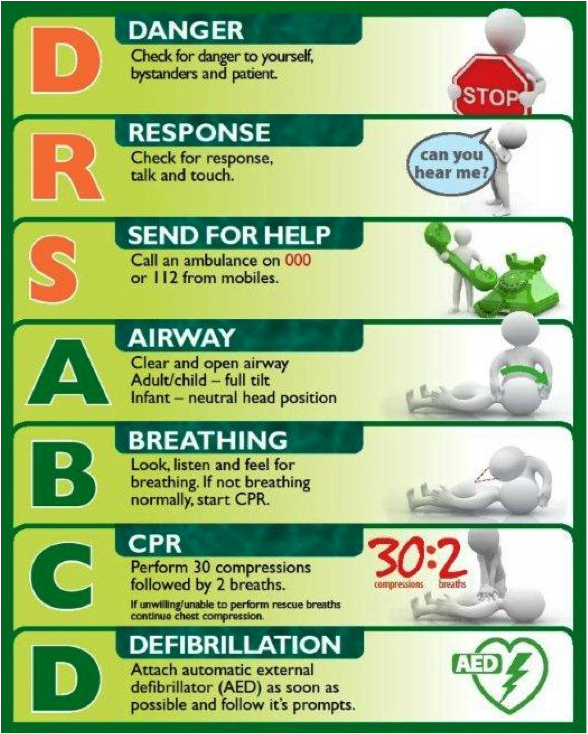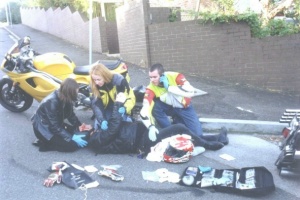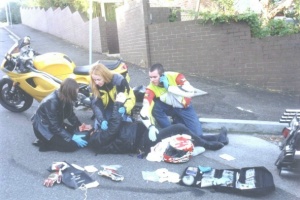Rider Injuries and Conditions
Like any high velocity sport, riding a motorcycle has the potential to cause life threatening injuries including shock, head, neck and spinal damage, profuse blood loss, traumatic wounds, burns, fractures and unconsciousness.
Immediate first aid is critical and has the potential to make a big the difference to the outcomes for a casualty.
With the typical high impact injuries sustained by motorcyclists, the following factors are imperative to survival:
- the ability to breathe effectively,
- minimise blood loss,
- protect the head, neck and spine and
- the quick arrival of medical attention.
A skilled and confident first aider can achieve this with the right training at a First Aid for Motorcyclists course.
Emergency Life Support
Follow the standard D.R.S.A.B.C action plan to effectively manage casualties and the accident scene.
First responders need to consider many things and act fast to secure the scene, for example:
- managing the traffic,
- calling 000 for emergency services and
- attending to the casualty’s injuries.
D – Danger
Check it’s safe to approach the injured person – traffic, powerlines, fire.
Don’t forget infection risk, wear gloves.
R – Response
Check if the casualty is conscious or unconscious – use visual, verbal, and touch techniques
S – Send for help
Call emergency services 000 as soon as possible
A – Airway
If obstructed, roll the casualty into the recovery position to clear
B – Breathing*
Look, listen & feel for normal breathing.
If airway remains obstructed or the casualty is not breathing normally, roll onto back, remove full face helmet** and commence CPR
C – CPR**
Begin with 30 chest compressions then 2 breaths (30:2)
Airway and Breathing* – If the casualty’s airway remains obstructed or breathing is laboured, inconsistent, or constricted, then treat as NOT BREATHING.
Helmet Removal** – If the rider is not breathing* a helmet (typically full-face) that prevents access to an airway must be removed immediately for CPR to commence. It is “life over limb” so act fast! Get professional training to perform this vital task. If you don’t know how to remove a helmet correctly then get training. If you are not confident removing helmet, just do chest compressions continuously – hard and fast.
Helmet Removal
A full-faced helmet should only be removed if the injured rider is not breathing* effectively and the helmet prevents access to the airway.
In all other circumstances the helmet should remain in place with chin strap undone as it provides excellent support for the delicate cervical vertebrae, so ask the rider to leave it in place until medical aid arrives. Monitor the casualty’s breathing closely and be ready to remove if airway or breathing are compromised.
If you want training on how to remove a helmet from an unconscious casualty who is not breathing normally then enrol in a First Aid for Motorcyclists course today!
Bleeding
Bleeding wounds can be hidden from view by clothing. Often the puncture made in the Kevlar or leathers is not a true indication of the severity of a wound. Profuse and life threatening blood loss requires that the wound be exposed to the first aider so that direct pressure can be applied with bandages or clothing.
Remember to wear gloves and protect yourself and the casualty from infection. For a large gash or open wound hold the wound together and apply pressure with dressings or clothing to minimise blood loss. If possible, elevate the bleeding part above the level of the chest and keep the injured person as still as possible.
Avoid giving food or fluids as they may need to go directly into the operating theatre on arrival to hospital.
Shock
To minimise the physical impact of circulatory shock, keep the casualty calm and still. It’s vital that you provide reassurance and remain calm yourself.
Where possible lay them down and cover them with a blanket as their body temperature will drop.
Shock occurs when the oxygen supply to vital organs is inadequate.
Circulatory shock is a life-threatening medical emergency and once it begins it tends to make itself worse, so immediate treatment is critical.
Keep their mind off their injuries, REASSURE them and REMAIN calm yourself.
Severe Burns
It is possible that a rider can be trapped underneath his or her bike.
Extreme heat from exhausts and engine parts can be conducted and contained in leathers, burning the rider. The road surface can burn too.
Apply cool, running water for a minimum of 20 minutes. If this is not available, you may need to improvise; use bottled water for example.
Remove clothing if possible from the burnt area. If it is stuck, cut around it; don’t attempt to pull it off. Remove jewellery to prevent restricting circulation due to swelling. Protect the burnt area with a sterile or non-stick dressing or closely woven material.
Fractures
In the case of a suspected fracture, keep the injured person as still as possible by packing clothing and equipment around them to prevent movement.
Equipment
First Aid for Motorcyclists have compact, lightweight, water resistant motorcycle first aid kits available at the course.
Want to learn more?
Reading this information is not enough
Enrol and attend a First Aid for Motorcyclists course where you’ll practice and learn these skills through a variety of demos, practice and scenarios. By the end of the half-day session you will understand what decisive steps are needed to confidently manage the rider’s injuries and the motorcycle accident scene.

Disclaimer: Neither The Motorcycle Council of NSW nor First Aid for Motorcyclists can be held liable for any actions or inaction by any person or persons as a result of the information provided.


